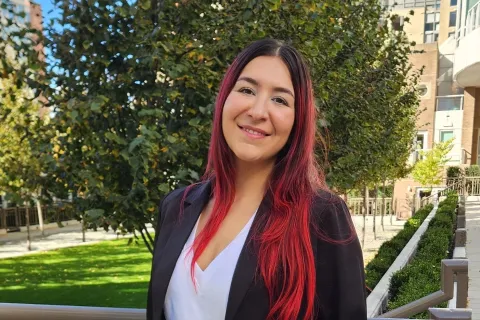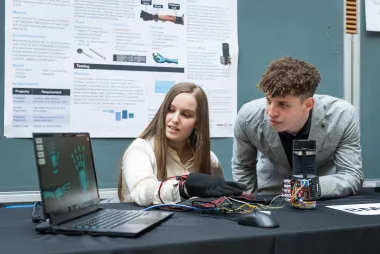
Delaram Behnami
- Degrees:
- Bachelor of Applied Science,
- Doctor of Philosophy,
- Master of Applied Science
- Program:
- Campus: Vancouver
Job: Senior Machine Learning Scientist, Getty Images
Delaram Behnami is a values-driven professional working at the leading edge of machine learning and AI. In her current position as a Senior Machine Learning Scientist at Getty Images, she is working at the intersection of supporting ethically generated AI imagery and ensuring content on the Getty Images platform is authentic to the real world.
Tell us about your current position at Getty Images.
I’m a Senior Machine Learning Scientist at Getty Images. Getty Images is a global visual media company and supplier of millions of creative stock and editorial photos and videos. It is a marketplace where businesses or individuals can browse, search and purchase content created by creators from around the world. Creators can submit their original work that respects specified legal and technical guidelines and be featured on Getty Images, where their work, which they own the copyright to, can be legally licensed for various needs, such as advertising campaigns.
My team (Artificial Intelligence, Machine Learning) and I work on the two sides of the generative AI coin:
- ensuring our customers are confident that imagery on our platform is real and authentic
- providing customers with commercially safe ways to generate AI content through our own tools and services.
Our Generative AI by Getty Images model was trained on licensed creative imagery, so none of our editorial content was included in the training set. Furthermore, it compensates creators whose original work has been used to train our model on an ongoing basis - not a one-time fee.
Our main objectives with this work are 1) to enable our customers to explore the power of generative AI without creating commercial risk and 2) to ensure this opens additional revenue streams for our contributor base.
Tell us about your academic journey.
I actually come from the world of biomedical AI research. I would describe my academic research field as the intersection of machine learning, computer vision, and medical imaging – or you could say, AI for disease screening and diagnostic assistance, and imaging guidance.
The initial spark of interest in machine learning was ignited in my final-year Electrical and Computer Engineering (ECE) undergraduate Capstone project, under the supervision of Dr. Purang Abolmaesumi with Change Healthcare (formerly McKesson Imaging), a medical imaging company with a Canadian office in Richmond, BC.
Capstone Dr. Purang Abolmaesumi
We developed an AI tool to determine patient orientation in chest X-rays, to ensure the correct side of the body is selected for surgery planning. Believe it or not, there are actual records of surgeons cutting into the wrong side of a patient due to misreading an X-ray! Our solution resulted in a joint UBC-industry patent in 2016, which marked my introduction to this field.
Having developed a taste for this space, I pursued a master’s degree under the guidance of Dr. Abolmaesumi and Dr. Robert Rohling. My research involved utilizing statistical shape and pose AI models to align pre-operative CT (computed tomography) and MR (magnetic resonance) images of the lumbar spine to intra-operative ultrasound images. Fusing different imaging modalities with AI models can enhance visibility for clinicians to assist and guide epidurals and facet joint needle insertions.
At this point, I was fully invested in AI in medical images, not to mention the overall grad school atmosphere, including our lab (Robotics and Control Lab (RCL)) with all its ultrasound machines, phantoms, and surgical robots casually around, international conferences, and the whole thing!
I was determined to pursue a PhD next, and deep learning was all the hype! I was fortunate to do my PhD research on applications of machine learning in heart disease.
My PhD research meant a lot to me. My dissertation involved developing a machine learning framework to diagnose heart disease in echocardiography (aka echo, i.e., real-time ultrasound image streams of the heart). Echo is an extremely complex modality to capture and read, and the heart is a highly complex dynamic organ with numerous complications and nuances, so making sense of echo requires extensive training. If we can use AI to assist clinicians, particularly those without extensive training or those in rural areas, in capturing and understanding echo images, we may be saving lives. Our team, led by Dr. Abolmaesumi and Dr. Teresa Tsang worked closely with Vancouver Coastal Health (VCH). The project then expanded to all British Columbian regional health authorities in partnership with Providence Health Care and industry, funded by Canada Digital Supercluster. Our machine learning and clinical teams have since published dozens of peer-reviewed papers and received several patents.
During my senior years of PhD, in those early pandemic years, I also started working in industry. I worked as an intern and then as a Machine Learning Applied Scientist at Amazon (Special Projects), on a client project in the health-care space. As part of an interdisciplinary team of scientists, I contributed to the development of solutions that automate image acquisition, quantification and characterization of lab study results using computer vision and machine learning.
Seeking to engage more deeply in academic research, I took on the role of Research Manager at the UBC Department of Medicine over the last year-and-a-half of my PhD. My role involved Department- and Faculty-level strategic planning to bring data science to health and medicine in the academic setting, as well as research support. I worked closely with the founders of the Data Science in Health (DASH) Research Cluster, Department Head Dr. Anita Palepu, Associate Head of Research Dr. Tsang, and the Faculty of Medicine on initiatives to enable deeper and broader applications of data science in health research. These initiatives included enhancing literacy and access for researchers in health to data science tools and knowledge, inventorying health data assets, and grant development to support and sustain such activities. Additionally, in this role, with Drs. Tsang, Abolmaesumi, and Anna Meredith, we developed a research grant proposal for the prestigious CFI John R. Evans Leaders Fund (JELF) to support the technical infrastructure required for further research in machine learning applications for the detection and management of heart failure.
This grant, approved in 2023, supports machine learning academic research aimed at improving provincial health outcomes related to heart disease.
Besides research, as any good (and economically aware) graduate student, I also TA’d for a few courses throughout the years (one for seven times!), organized and taught some technical and non-technical workshops, and tutored high school students in math and physics in my earlier years. In 2019-2020, with professors Dr. Matt Yedlin and Dr. Bhushan Gopaluni and my peers, Drs. Mohammad Jafari, Fatemeh Dezaki, and Lee Rippon, we developed a pilot machine learning course, which continues to be offered to graduate students in the Department of ECE.
Any advice for students starting out?
Get involved. Join a club or sport activity, TA for a course, do a co-op or an internship, but also grab a coffee with your classmates or labmates after a class or a meeting, book a room on campus and watch a game with your buddies, whatever it might be.
Don’t pass up on opportunities to connect with people – it will help you get out of your own head!
One thing I am glad I did in my education is that I got involved in a whole bunch of colourful activities at UBC over the years, and I like to think it totally paid off – I enjoyed myself! I served as the Graduate Vice Chair of the UBC Women in Engineering, and was the President of the UBC Electrical and Computer Engineering Graduate Student Association (ECEGSA) and a member of the UBC Persian Club. We hosted parties for Nowruz (Persian New Year) and Yalda (Persian celebration of the winter solstice), fundraising events, deep learning workshops, and screenings of soccer matches! With my friends and classmates, we would do after-hour jam sessions at the student lounge, karaoke nights, belly dancing classes, and mid-day walks down to Wreck Beach! It made my school years very fun, and it also taught me how to relate and interact with a wide range of people, how to communicate my ideas more effectively (which comes in handy in fields like engineering, where communicating abstract and complex ideas can be challenging), and how to hold small talk before an important corporate meeting starts! My point being, beyond the coursework and the ambition, find ways to connect – it’s worth it!

